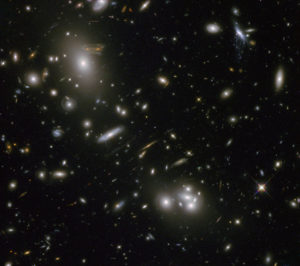 Dark matter is the name of a theoretical type of matter that may occupy large amounts of the universe. Named for its inability to be observed through conventional means, it is currently believed to occupy around 80% of the universe’s total mass, its effects felt via the gravity it exudes on its surroundings.
Dark matter is the name of a theoretical type of matter that may occupy large amounts of the universe. Named for its inability to be observed through conventional means, it is currently believed to occupy around 80% of the universe’s total mass, its effects felt via the gravity it exudes on its surroundings.
Science News reports on new discoveries related to the mysterious substance, specifically with regards to the dark matter in galaxy cluster Abell 3827. Located about 1.3 billion light years from Earth, astronomers have observed strange interactions between dark matter in the region – namely, that it doesn’t interact.
Things were already somewhat alarming in the cluster, as it was recently found that the stars that occupy Abell 3827 had separated from their dark matter. While some theorized that the dark matter had fallen behind the galaxies because of interactions with other dark matter in the area (something that isn’t supposed to happen), observation via Chile’s Atacama Large Millimeter Array disproved this idea, showing that it is business as usual for the substance.
Why, then, is the dark matter behaving this way? Currently, there’s no clear answer as to why. Based on all current models of how dark matter works, as well as models of how the Abell 3827 cluster should be acting, there is nothing out of the ordinary with the dark matter, meaning it should not be separated from its stars. It has, though, leading scientists on a journey to try and understand why.
Using a balloon-mounted telescope called SuperBIT, cosmologist Richard Massey (the original theorist behind the dark matter’s interaction with itself) and his team hope to observe other areas of space in the region to find out what the dark matter is up to in the surrounding cosmos. What they find could potentially explain what’s going on in Abell 3827, but might just raise even more questions. As Massey himself admits, we currently know “embarrassingly little” about dark matter itself.





